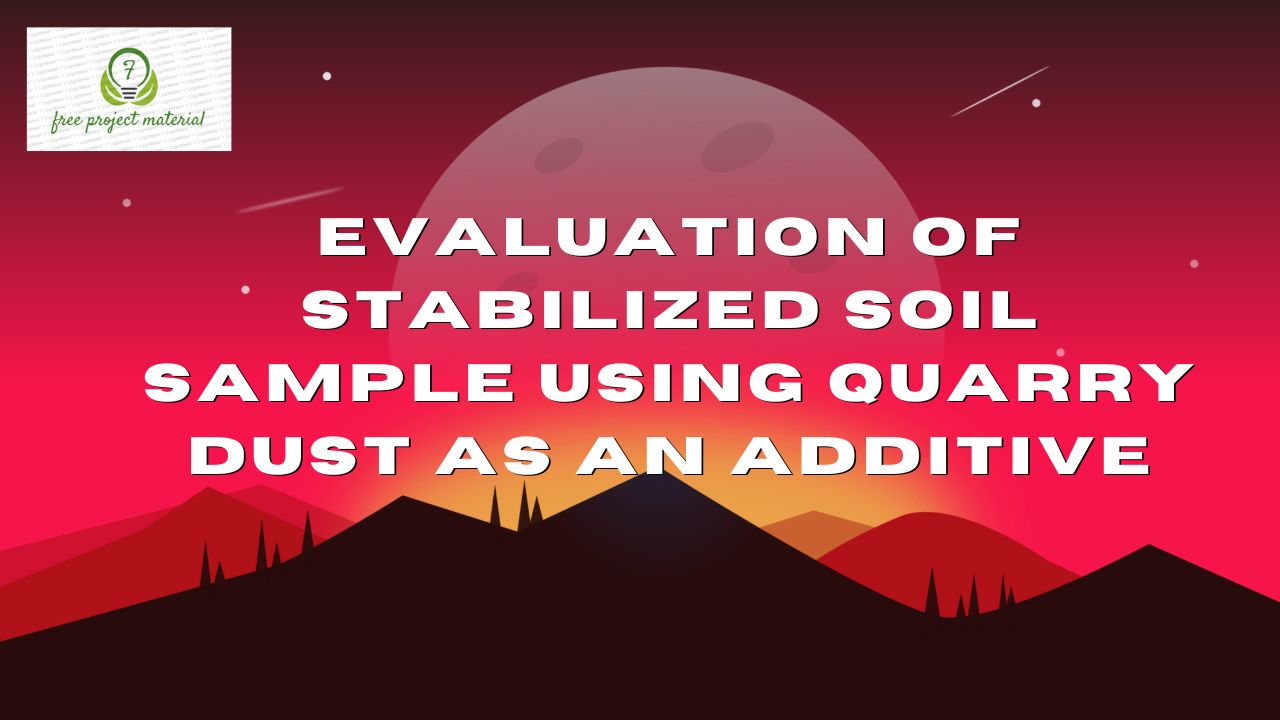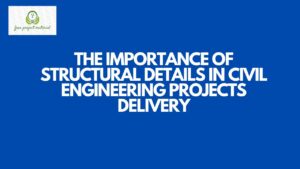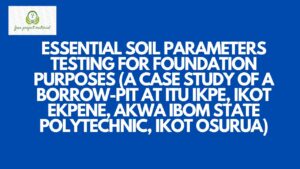ABSTRACT
The stabilization of soil is important in construction of foundation and highways as it improve the engineering properties of soil like compressibility and shear strength in the experiment result obtained in the laboratory on expansive soil treated with low cost materials (quarry dust) are presented. A study is carried out to check the improvement in the properties of stabilized soil with addition of quarry dust in different percentages. The test result foe as Atterbrg’s limit specific gravity, sieve analysis, compaction characteristics, differential free swelling index, unconfined compressive strength obtained from the test on stabilized sample mixed are presented and discussed in this paper. The chapter one of the project or research is the introduction, will explain more about studies and definition of terms.
LIST OF TABLES
Table 1: compaction test – – – – – – – 129
Table 2: Specific Gravity Test – – – – – – 45-54
Table 3: Bulk Density – – – – – – – 126-128
LIST OF FIGURES
Graph (a) Compaction
Graph (b) Sieve
TABLE OF CONTENTS
Contents Pages
Title Page – – – – – – – – – i
Certification – – – – – – – – ii
Dedication – – – – – – – – – iii
Acknowledgements – – – – – – – iv
Abstract – – – – – – – – – v
List of Table – – – – – – – – vi
List of Figures – – – – – – – – vii
Table of Contents – – – – – – – – viii-x
CAHPTER ONE
1.0 Introduction – – – – – – – – 1
1.1 Background of the Study – – – – – – 1
1.2 Statement of the Problem – – – – – – 1
1.3 Objectives of the study – – – – – – 1-2
1.4 Significance of the Study – – – – – – 2
1.5 Scope and Limitation of the Study – – – – 2
1.6 Definition of Terms – – – – – – 2
CHAPTER TWO
2.0 Soil Stabilization – – – – – – 3
2.2 Types Of Soil Stabilization- – – – – – 3-4
2.3 Method Of Soil Stabilization – – – – – 4
2.3.1 Cement Stabilization – – – – – – 4-6
2.3.2 Lime Stabilization – – – – – – 6-8
2.3.3 Pozzolanas – – – – – – – – 8-9
2.3.4 Stabilization Using Fly Ash – – – – – 9
2.4 Importance Of Soil Stabilization – – – – 10
2.5 Difficulties in Soil Stabilization – – – – 10-11
2.6 Factors Affecting Soil Stabilization – – – – 12-15
2.7 Properties of Soil – – – – – – – 15-17
2.8 Quarry Dust – – – – – – – 18
2.8.1 Importance Of Quarry Dust – – – – – 18
2.8.2 Application Of Quarry Dust – – – – – 18-19
2.8.3 Aim of Using Quarry as an Additive – – – 19
2.8.4 Benefit Of Using Quarry Dust – – – – – 19-20
CHAPTER THREE
3.0 Methodology – – – – – – – 21
3.1 Preparation of Material – – – – – – 21
3.2 Methods – – – – – – – – 22-34
CHAPTER FOUR
4.0 Result and Discussion – – – – – – 35
4.1 Results – – – – – – – – 35
4.1.1 Sieve Analysis – – – – – – – 35-42
4.1.2 Specific Gravity – – – – – – – 43-53
4.1.3 Bulk Density Test – – – – – – 54-69
2.4.4 Moisture Content – – – – – – – 69-74
2.4.5 Compaction Test – – – – – – – 75-121
4.2 Discussion of Result – – – – – – 122-130
CHAPTER FIVE
5.0 Conclusion and Recommendation – – – – 131
5.1 Conclusion – – – – – – – – 131
5.2 Recommendation – – – – – – – 132-133
CHAPTER ONE
1.0 INTRODUCTION
Quarry dust is a byproduct of the crushing process which is a concentrated material to use as aggregates for concreting purpose, especially as fine aggregates.
In quarry activities the rock has been crushed into various size during the process of the dust generated as called QUARRY DUST and it is formed as a waste. So it becomes as a useless material and also result in air pollution.
The stabilization of soil is important in construction of foundation and highway as it improves the engineering properties of soil like compressibility, permeability and shear strength. Therefore quarry dust should be used in construction. The construction materials would be save and natural resources can be used conservatively.
Soil stabilization aims at improving soil strength and increasing resistance to softening by water through bonding the soil particles together, water proofing the particles or combination of the two (Sherwood, 1993). Usually, the technology provides an alternative provision structural solution to a practical problem. The simplest stabilization processes are compaction and drainage (if water drains out of wet soil it becomes stronger). The other process is by improving gradation of particle size and further improvement can be achieved by adding binders to the weak soils (Rogers et al, 1996).
1.2 STATEMENT OF PROBLEM
Stability of soils overtime has experienced a changing phase as more materials are used to establish to what degree it can be manipulated so as to determine the required strength design. Therefore with research being undertaken on materials for use as stabilizers it is important to note that other factors such as the efficiency, cost etc. ought to be considered for use of that material as compared to those that have been used before. In cases of road rehabilitation, during excavations rather than disposing off of the asphalt pavement layer as waste material it would be more economical to use it as a soil stabilizer as it:
Conserves energy-
- Preserves the environment-There is no disposal as the waste is recycled.
- Reduces cost of construction-When compared to other treatment alternatives that have to be acquired at a cost, it is cheaper as it is available at no cost.
- It preserves existing pavement geometrics-After excavation the original alignment is maintained and is often used for the new road.
1.3 AIMS AND OBJECTIVES OF THE STUDY
- To determine various index properties of soil with quarry dust
- To improve the Engineering properties of soil such as an increase the (CBR) value, reduce permeability, increase the compressive strength and to increase the shear strength
- To reduce plasticity.
- To determine the effect of quarry dust on plasticity and shrinkage of lateritic gravel as sub material.
- To determine the effect of quarry dust on bearing strength of lateritic gravel as sub base material.
1.4 SIGNIFICANCE OF THE STUDY
The need for the study is to provide maximum improvement effect to quarry dust on lateritic. It is necessary for civil engineering professional to know the effect of quarry dust as an additive on lateritic. Also, a lasting solution provided to the constant road failure done to poor sub-grade, sub-base course materials.
1.5 SCOPE AND LIMITATIONS
This study will be confined to the test for bearing capacity, plasticity index, shrinkage limit, particle size distribution, and the environmental conservation.
The limited time frame of the research would not allow for assessment of the durability of the roads and comprehensive cost analysis. This was because it would take a long time to come up with conclusive reports on performance and the expected life of the resulting road pavement. The benefit cost analysis could not be undertaken as comparison with other alternatives would need longer period for evaluation.



